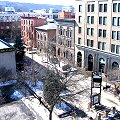- By Downtown Ithaca Alliance
- Around Town
 Print
Print  When it comes to housing in downtown Ithaca, a significant need for additional units is evident, according to the recently released Downtown Ithaca Housing Demand Study.
When it comes to housing in downtown Ithaca, a significant need for additional units is evident, according to the recently released Downtown Ithaca Housing Demand Study.The analysis, conducted this year by the Danter Company, a national housing market research firm, shows that a housing demand for up to 1,050 housing units downtown exists over the next five years. The study recommends that these new residences could include up to 350 additional for-sale housing units and around 1,000 purpose built student beds.
In addition, the 2016 Danter study of downtown housing identified a significant gap in so called "purpose built" student housing.
The need for this additional housing stems from the city's continued growth in its student, senior citizen, and medium-income population, said Danter Company President and CEO Kenneth Danter.
The housing that should be developed in downtown Ithaca over the next five years needs to hit all of the renter and buyer price points; however, an emphasis should be placed on creating housing that reaches middle income households, Danter said.
"Permanent residents move up through a series of housing choices and price points. A (shortage) in any specific portion of the market impacts those product lines above. The lack of middle market rental product for the non-student market eventually impacts the homeownership market ... It is important to provide step up alternatives in order to continually 'recharge' the single-family resale market," Danter said.
Rental Housing
The Danter study divides downtown rental housing into four product types- luxury, upscale, affordable/moderate, and subsidized family/senior. While all of these segments are expected to see additional demand, the moderate/affordable and subsidized product types show the greatest unmet demand. Since developers in Ithaca as well as around the country have found it difficult to build new urban moderate and affordable housing, it is likely that construction of this type of housing will require some public incentive not now available.
Over a five year period, these four downtown rental housing types are estimated to need another 900 to 1,050 new units - roughly a third upscale and luxury, a third moderate and affordable, and a third subsidized for families and seniors.
Currently, the vacancy rate for larger (24+ unit) Downtown multi-family properties stands at 1.8%. Any vacancy rate less than 5% is considered low.
For Sale Housing
Downtown for-sale or condominium housing has been the subject of community discussion for some time. The Danter study found a sizable unmet demand for downtown condominium housing -- 300 - 350 units during the next five years.
This demand is clustered around specific price points -- within the $200,000 to $500,000 price range. Similar to the rental market, lower priced for sale units are difficult to bring into the marketplace. While half of the downtown condominium demand is for units costing under $250,000, there will likely be a need for some subsidy or support to develop these type of units.
Purpose Built Student Housing
Purpose built student housing is constructed specifically for the student market and contains amenities and features geared towards students. In Ithaca only 6% of the net student population is housing in purpose built properties. Based on national averages, Danter notes that this percentage should be between 20% and 35%.
The study estimates that Downtown Ithaca could support up to 1,000 student beds over the next five years.
"Students are and will continue to be a dominate factor in the Ithaca rental housing market and they are important for the success of residential housing, as well as, the retail and commercial economy in downtown Ithaca," Danter said in the report.
The Downtown Ithaca Alliance (DIA), a not-for-profit organization charged with promoting, facilitating, and managing the revitalization of Downtown Ithaca, announced it agrees with the study's findings.
Executive Director Gary Ferguson said the DIA recognizes the need for more living spaces and it is working with our local governments to bring projects downtown that will help address the housing shortage. The DIA will also work with the local governments to create programs and policies that will make these projects affordable to develop and live in.
"Based on the downtown study and Tompkins County's analysis, it is clear that there remains a strong demand for housing in downtown and the county. Urban center-city living has become a national obsession. From our largest to our smallest cities people are seeking out urban living. No longer just a novelty, downtown living has become a popular movement that shows no sign of slowing," Ferguson said.
v12i36



